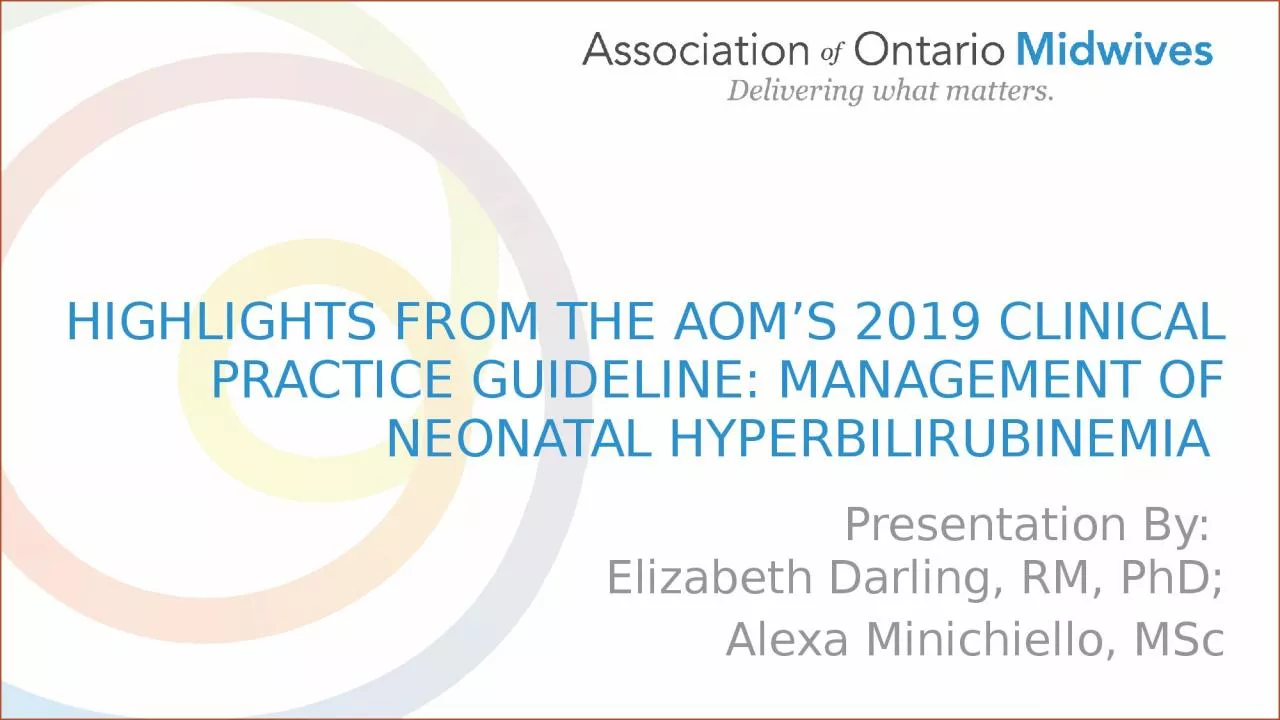

Presentation By Elizabeth Darling RM PhD Alexa Minichiello MSc 1 CPG Development Process Overview 2 Example Recommendations 3 Knowledge Translation Resources CPG Development PROCESS ID: 927955
Download Presentation The PPT/PDF document "Highlights from the AOM’s 2019 Clinica..." is the property of its rightful owner. Permission is granted to download and print the materials on this web site for personal, non-commercial use only, and to display it on your personal computer provided you do not modify the materials and that you retain all copyright notices contained in the materials. By downloading content from our website, you accept the terms of this agreement.
Slide1
Highlights from the AOM’s 2019 Clinical Practice Guideline: Management of Neonatal Hyperbilirubinemia
Presentation By:
Elizabeth Darling, RM, PhD;
Alexa Minichiello, MSc
Slide2Slide31.
CPG Development
Process
Overview
2.
Example
Recommendations
3. Knowledge Translation Resources
Slide4CPG Development PROCESS
Slide5Slide6Hyperbilirubinemia CPG
Focus:
The management of severe hyperbilirubinemia in the otherwise healthy term and late preterm infants.
Discusses:
Definition and incidence
Risk factors PreventionScreeningTreatment/ManagementClient experiences
Slide7Methodology
Reviewed literature from
2001-2018
This CPG uses the
Grading of Recommendations, Assessment, Development and Evaluation (GRADE) methodology for guideline development
Slide8GRADE Process
GRADE determines:
1
. The certainty of the evidence.
A) Risk of bias,
B) Inconsistency, C) Indirectness, D) Imprecision, and E)
Publication bias.2. The strength of the recommendation.HighVery LowModerateLow
Strong OR Weak
Slide9Example RECOMMENDATIONS
Slide10Sunlight
Research Question:
Can sunlight be used to prevent the development of severe hyperbilirubinemia?
Slide11Sunlight – GRADE Approach
One study found that
t
he need for exchange transfusion was lower among infants who received sunlight compared to phototherapy
.
Historical
Small sampleWrong populationConfounding variables
Insufficient evidenceMeasurement concernsHealth risks
Slide12Sunlight
Recommendation:
There is insufficient evidence to support the use of sunlight as a means of preventing the development of severe hyperbilirubinemia.
No recommendation: very low certainty of evidence
Slide13Visual Assessment
Research Question:
Can visual assessment alone be used to screen for severe hyperbilirubinemia?
Slide14Visual Assessment – GRADE Approach
4 studies found variable results
Visual assessment cannot detect all babies with higher bilirubin levels
Inconsistency
Indirectness
Uncertainty of consequences
Missed infants
Visual assessment is valued
Slide15Visual Assessment
Recommendation:
The use of visual assessment alone is not recommended for screening for severe
hyperbilirubinemia.
Weak recommendation: very low certainty of evidence
This recommendation recognizes that visual assessment for hyperbilirubinemia is an important part of the overall clinical assessment of a newborn but should not be relied on alone to determine a newborn’s risk of severe hyperbilirubinemia.
Slide16Universal Screening
Research Question:
Should all neonates be screened for severe hyperbilirubinemia within 24-72 hours of life regardless of risk factors?
Slide17Universal Screening – GRADE Approach
8 studies
Potential benefits associated with universal screening
Risk of confounding
Inconsistency
Indirectness
Applicability to midwifery context
Systemic barriersConsequences for clients
Slide18Universal Screening – Recommendation 1
Recommendation:
The risks and benefits of universal screening should be discussed with all clients as part of an informed choice discussion.
This discussion may address:
what is known about risk factors, if present;
how visible jaundice, poor feeding, dehydration and weight loss impacts the risk of developing severe hyperbilirubinemia;
what is known about the limitations of visual assessment of jaundice;optimal timing of screening: between 24 to 72 hours of age;barriers to and enablers of screening within the client’s community context; andthe client’s values and preferences and risk tolerance.Weak recommendation: very low certainty of evidenceThis recommendation recognizes the paucity of high-certainty evidence on the effectiveness of universal screening, the uniqueness of the midwifery context and structural barriers which impact midwives’ ability to offer community-based bilirubin screening.
Slide19Universal Screening – Recommendation 2
Recommendation:
If visible jaundice develops, obtaining a bilirubin measurement is recommended.
For neonates who have previously had a negative TSB screen and in whom visible jaundice subsequently develops, midwives may use their clinical judgement in determining the need to re-screen. Consider presence or absence of other clinical factors associated with severe hyperbilirubinemia (e.g. suboptimal feeding, lethargy, dark urine, pale chalky stools).
Weak recommendation: very low certainty of evidence
This recommendation recognizes that the timely, frequent and close follow-up of neonates as a standard of midwifery care limits the benefits associated with universal screening while acknowledging the importance of the clinical manifestation of hyperbilirubinemia.
Slide20Knowledge Translation Resources
Slide21Client Resources
Slide22Midwifery Resources – Bilitool App
Mobile application to use at the point-of-care
Slide23Midwifery Resources – Management Care Pathway
Slide24Midwifery Resources – Bilimetre Comparison
Slide25Slide26